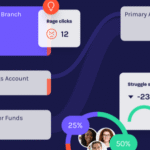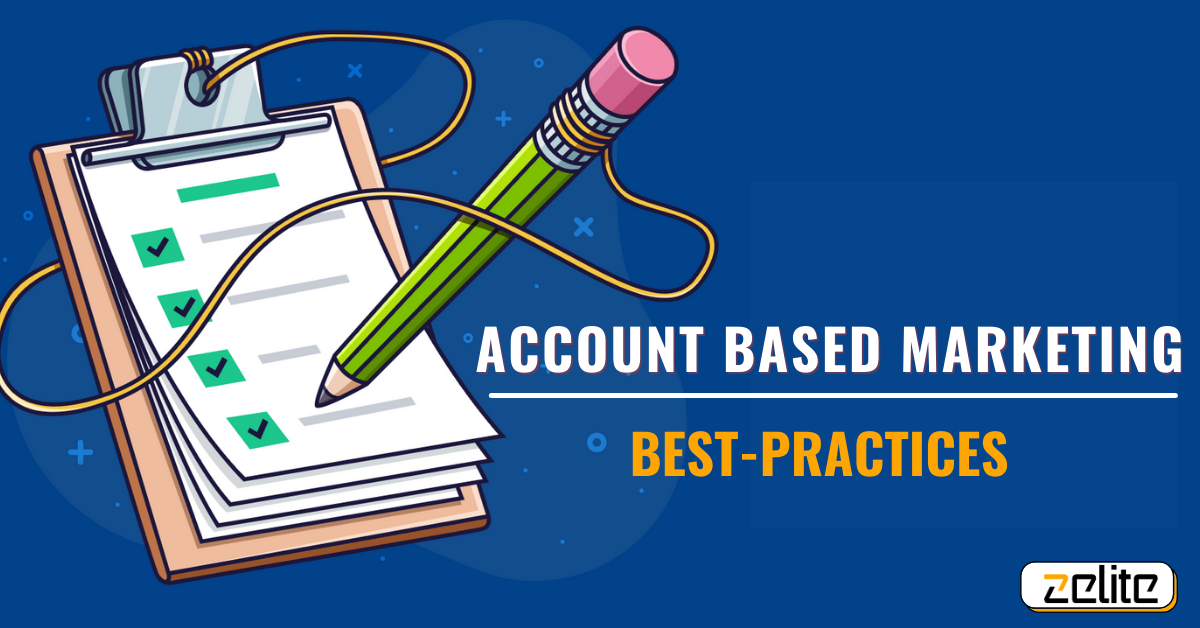
Boosting Email Response Rates: What Works
September 9, 2025
Why Singapore’s Leading B2B Lead Generation Agency Is a Game-Changer
September 10, 2025In today’s hyper-competitive business landscape, understanding and effectively navigating the buyer’s journey is crucial for B2B organizations. Account-Based Marketing (ABM) has emerged as a powerful strategy that allows businesses to target and engage key accounts in a personalized and strategic manner. By aligning marketing and sales efforts, ABM enables organizations to enhance customer relationships, drive revenue growth, and achieve long-term success. In this blog post, we will explore the best practices for navigating the buyer’s journey through Account-Based Marketing.

1. Identify and Define Ideal Customer Profiles: The first step in implementing a successful ABM strategy is to identify and define your ideal customer profiles (ICPs). This involves analyzing data, conducting market research, and collaborating with sales teams to create detailed profiles of your target accounts. By understanding their pain points, challenges, and buying preferences, you can tailor your marketing efforts accordingly.
Identifying and defining ideal customer profiles (ICPs) is a critical step in implementing a successful Account-Based Marketing (ABM) strategy. ICPs help organizations focus their efforts on the most valuable accounts that are likely to yield the highest returns. Here are some key steps to identify and define ideal customer profiles in ABM:
-
Analyze Existing Customer Data: Start by examining your existing customer base to identify common characteristics and patterns among your most successful and satisfied customers. Look for factors such as company size, industry, geographic location, revenue, and purchasing behavior. This analysis will provide insights into the types of accounts that align well with your offerings and have the highest potential for success.
-
Conduct Market Research: Conduct thorough market research to gain a deeper understanding of the industry landscape and trends. Identify target markets with growth potential and evaluate the competitive landscape. This research will help you identify segments within the market that align with your organization’s strengths and expertise.
-
Collaborate with Sales Teams: Involve your sales teams in the ICP identification process. Sales teams have valuable on-the-ground experience and insights into customer needs and pain points. Conduct joint meetings and workshops to gather input from sales representatives. Their firsthand knowledge will help refine and validate the ICP criteria.
-
Develop Firmographic and Demographic Criteria: Based on the analysis of existing customer data, market research, and input from sales teams, develop firmographic and demographic criteria that define your ideal customer profiles. Firmographic criteria may include factors such as company size, industry, revenue, location, and organizational structure. Demographic criteria may include job titles, roles, responsibilities, and key decision-makers within the target accounts.
-
Identify Psychographic and Behavioral Factors: In addition to firmographic and demographic criteria, consider psychographic and behavioral factors that influence buying decisions. These factors delve into the motivations, pain points, challenges, and preferences of your target accounts. Psychographic factors may include values, goals, and attitudes, while behavioral factors may include engagement with industry events, online communities, or specific content types.
-
Validate and Refine ICPs: Once you have defined your initial ICPs, it is important to validate and refine them over time. Continuously assess the performance of your ABM campaigns against the identified ICPs. Seek feedback from sales teams, track conversion rates, and analyze engagement metrics to ensure your ICPs are effectively guiding your targeting and messaging strategies. Adjust and update the ICP criteria as needed to improve campaign effectiveness.
-
Segmentation and Tiering: Based on the defined ICPs, segment your target accounts into different tiers or categories. This allows you to allocate resources and tailor your ABM strategies based on the potential value of each account. Assign higher priority and more personalized approaches to Tier 1 accounts that closely match your ICPs and have the greatest revenue potential.
By identifying and defining ideal customer profiles in ABM, organizations can focus their resources, align their strategies, and personalize their messaging to engage the right accounts at the right time. This targeted approach increases the chances of success and generates stronger relationships with key accounts, ultimately driving revenue growth and long-term business success.
2. Align Marketing and Sales Teams: Successful ABM requires close collaboration between marketing and sales teams. By aligning their efforts and goals, organizations can ensure a seamless transition throughout the buyer’s journey. Regular communication, shared metrics, and joint planning sessions can foster a unified approach that enhances the customer experience and maximizes conversion rates.
Aligning marketing and sales teams is crucial for the success of Account-Based Marketing (ABM) initiatives. When both teams work together seamlessly, they can effectively target, engage, and convert key accounts. Here are some steps to align marketing and sales teams in ABM:
-
Establish Shared Goals and Objectives: Ensure that marketing and sales teams have a clear understanding of the overall organizational goals and how ABM aligns with them. Collaboratively establish shared goals and objectives that both teams can work towards. This shared vision will create a sense of unity and purpose, fostering alignment.
-
Foster Open Communication: Encourage regular and open communication between marketing and sales teams. Establish channels for ongoing collaboration, such as joint meetings, shared project management tools, and communication platforms. This facilitates the exchange of ideas, feedback, and updates, allowing teams to stay aligned and make informed decisions.
-
Develop a Service Level Agreement (SLA): Create a formalized Service Level Agreement (SLA) between marketing and sales teams. The SLA outlines the responsibilities, expectations, and deliverables of each team. It includes parameters such as lead qualification criteria, lead handoff processes, follow-up timelines, and feedback loops. The SLA provides clarity and accountability, ensuring a smooth handover of leads from marketing to sales.
-
Implement Shared Metrics and Reporting: Define and track shared metrics and key performance indicators (KPIs) that measure the success of ABM efforts. These metrics should align with the overall organizational goals and reflect the contributions of both marketing and sales teams. Regularly review and analyze the data together, identifying areas of improvement and celebrating successes as a unified team.
-
Conduct Joint Planning and Strategy Sessions: Organize joint planning and strategy sessions where marketing and sales teams collaborate on ABM initiatives. During these sessions, discuss target account selection, messaging, content creation, campaign strategies, and customer engagement approaches. By involving both teams in the planning process, you can leverage their expertise and ensure alignment from the outset.
-
Share Customer Insights and Feedback: Marketing teams gather valuable insights from customer interactions, content engagement, and market research. Share these insights with the sales team to help them understand the needs, preferences, and pain points of target accounts. Likewise, sales teams should provide feedback on customer interactions, objections, and challenges they encounter. This knowledge exchange enables both teams to refine their strategies and tailor their approaches.
-
Continuous Collaboration and Learning: Encourage ongoing collaboration and learning between marketing and sales teams. Foster a culture of knowledge sharing and cross-functional training. This can include joint training sessions, shadowing opportunities, or regular team meetings where best practices, success stories, and lessons learned are shared. By continuously learning from each other, both teams can improve their skills and drive better results.
By aligning marketing and sales teams in ABM, organizations can create a cohesive and synchronized approach to engaging key accounts. This alignment enhances customer experiences, improves conversion rates, and maximizes the impact of ABM initiatives. Together, marketing and sales teams can unlock the full potential of ABM, driving revenue growth and fostering long-term customer relationships.

3, Personalize Content and Messaging: A key aspect of ABM is delivering personalized content and messaging to engage target accounts. Leverage the insights gained from your ICPs to create tailored content that addresses their specific pain points and offers solutions. By demonstrating a deep understanding of their challenges and providing valuable insights, you can establish trust and credibility, positioning your organization as a valuable partner.
Personalizing content and messaging is a fundamental aspect of Account-Based Marketing (ABM) that allows organizations to engage target accounts on a deeper level and drive meaningful interactions. Here are some best practices for personalizing content and messaging in ABM:
-
Understand the Target Account’s Needs: Before creating content or developing messaging, it’s crucial to have a deep understanding of the specific needs, pain points, and challenges of the target account. Conduct research, review account-specific data, and leverage insights from sales teams to gain a comprehensive understanding of the account’s goals and objectives.
-
Tailor Content to Address Account-Specific Challenges: Once you have a clear understanding of the target account’s needs, develop content that directly addresses their specific challenges. Customize your messaging to provide solutions, insights, and value propositions that are relevant to their unique situation. This level of personalization demonstrates your understanding and positions your organization as a trusted advisor.
-
Leverage Account-Specific Data: Utilize account-specific data to personalize your content and messaging further. This can include referencing specific industry trends, mentioning recent news or events related to the account, or incorporating personalized data points in your communications. The more you can demonstrate that your content is specifically tailored to the account, the more impactful your messaging will be.
-
Use Personalization Technologies and Tools: Leverage technology and tools to automate and scale personalization efforts. Marketing automation platforms, customer relationship management (CRM) systems, and content management systems (CMS) often have personalization capabilities. Use dynamic content, smart fields, and behavioral triggers to deliver personalized experiences across channels, such as emails, website landing pages, and social media.
-
Segment and Target Messaging: Segment your target accounts into smaller groups based on specific criteria, such as industry, company size, or pain points. Craft tailored messaging for each segment to address their unique challenges and preferences. This approach allows for more precise targeting and resonates with different audiences within your target accounts.
-
Leverage Account-Specific Events and Initiatives: Stay informed about account-specific events, initiatives, or milestones. Use this knowledge to create timely and personalized content. Congratulate the account on achievements, offer support for upcoming projects, or provide insights related to their initiatives. This level of personalization demonstrates your attention to detail and your commitment to their success.
-
Engage Multiple Stakeholders: In B2B sales, decision-making often involves multiple stakeholders within an account. Personalize your content and messaging to cater to the interests and concerns of each stakeholder. Customize your communication to address the specific roles, responsibilities, and priorities of individuals within the account. This approach increases the chances of gaining buy-in from all stakeholders involved.
-
Continuously Refine and Optimize: Regularly review the performance and effectiveness of your personalized content and messaging. Analyze engagement metrics, conversion rates, and feedback from sales teams. Use this data to refine and optimize your content strategy, ensuring that your personalization efforts are delivering the desired results.
By personalizing content and messaging in ABM, organizations can create meaningful connections with target accounts, demonstrate their value proposition, and foster stronger relationships. The personalized approach not only increases engagement but also enhances the likelihood of conversion and long-term customer loyalty.

4. Utilize Multi-Channel Campaigns: Engaging target accounts requires a multi-channel approach. Utilize a combination of channels such as email marketing, social media, content marketing, and personalized direct mail to reach decision-makers across different touchpoints. Consistency in messaging and coordinated campaigns across channels can reinforce your brand and increase the chances of conversion.
Utilizing multi-channel campaigns is a powerful strategy in Account-Based Marketing (ABM) that enables organizations to reach and engage target accounts through various communication channels. By leveraging multiple channels, you can create a cohesive and integrated approach that increases the visibility and impact of your ABM efforts. Here are some best practices for utilizing multi-channel campaigns in ABM:
-
Understand Channel Preferences: Start by understanding the channel preferences of your target accounts. Research their preferred communication channels, such as email, social media, direct mail, industry-specific platforms, or events. This knowledge will help you tailor your multi-channel approach to meet their preferences and maximize engagement.
-
Segment Accounts and Channels: Segment your target accounts based on factors like industry, company size, or buying behavior. Analyze each segment’s characteristics and identify the most effective channels for reaching them. This segmentation allows you to allocate resources and customize messaging based on the preferences of different account segments.
-
Create Consistent Messaging Across Channels: Maintain consistency in your messaging across all channels. Ensure that your value proposition, key messages, and brand voice align across email campaigns, social media posts, direct mail materials, and any other channels you utilize. Consistency reinforces your brand and helps create a unified and recognizable experience for the target accounts.
-
Personalize Content for Each Channel: Tailor your content and messaging for each channel while keeping the core message consistent. Understand the strengths and limitations of each channel and adapt your content accordingly. For example, on social media, you may focus on short and engaging snippets, while email campaigns can provide more detailed information. Personalization enhances the relevance and impact of your messaging on each channel.
-
Coordinate Timing and Touchpoints: Coordinate the timing and touchpoints of your multi-channel campaigns to create a synchronized and cohesive experience for the target accounts. Plan the sequence and frequency of communications across channels to ensure that messages build upon one another and support the buyer’s journey. Consider the optimal timing for each channel based on the account’s engagement patterns and preferences.
-
Integrate Online and Offline Channels: Integrate both online and offline channels in your multi-channel campaigns. While digital channels are effective for quick and efficient communication, offline channels like direct mail or personalized gifts can create a tangible and memorable experience. By integrating online and offline touchpoints, you can reinforce your messaging and leave a lasting impression on the target accounts.
-
Leverage Marketing Automation and Analytics: Utilize marketing automation tools to streamline your multi-channel campaigns and ensure consistent delivery across channels. These tools allow you to schedule, track, and measure your communications, automate personalization, and analyze engagement metrics. Leverage the data and insights provided by these tools to optimize your campaigns and identify which channels are most effective.
-
Test and Optimize: Continuously test and optimize your multi-channel campaigns to improve their effectiveness. A/B test different messaging variations, call-to-action approaches, and channel combinations to determine what resonates best with your target accounts. Monitor the performance of each channel, track conversion rates, and adjust your strategy based on the insights gained.
By utilizing multi-channel campaigns in ABM, organizations can engage target accounts through various touchpoints, increasing the visibility and impact of their messaging. This approach allows for a comprehensive and tailored communication strategy that addresses the diverse preferences and behaviors of target accounts, ultimately driving higher engagement and conversion rates.
5. Leverage Data and Analytics: Data and analytics play a crucial role in optimizing ABM campaigns. Track and measure the effectiveness of your campaigns, monitor engagement levels, and identify areas for improvement. By leveraging insights from data, you can refine your strategies, segment accounts more effectively, and deliver targeted messages at the right time in the buyer’s journey.
Leveraging data and analytics is a critical component of successful Account-Based Marketing (ABM) strategies. By harnessing data insights and utilizing analytics tools, organizations can make informed decisions, optimize their targeting, and measure the effectiveness of their ABM efforts. Here are some key ways to leverage data and analytics in ABM:
-
Identify Target Accounts: Utilize data and analytics to identify and prioritize target accounts for your ABM campaigns. Analyze firmographic data, such as company size, industry, revenue, and technographic information, to identify accounts that align with your ideal customer profile. Data-driven insights help you focus your resources on accounts with the highest potential for success.
-
Account Segmentation: Segment your target accounts into groups based on shared characteristics or behaviors. Use data to identify segments that require specific messaging or tailored approaches. This segmentation allows you to personalize your ABM strategies and optimize engagement with different account groups.
-
Buyer Persona Development: Leverage data and analytics to develop detailed buyer personas for key decision-makers and influencers within the target accounts. Analyze data on job titles, responsibilities, pain points, and preferences to create personas that inform your messaging, content creation, and engagement strategies. These personas provide a deeper understanding of your target audience, enabling you to deliver more relevant and effective campaigns.
-
Data Enrichment: Augment your existing data with external data sources to enrich your understanding of target accounts. This can include information on company news, social media activity, technology usage, or intent signals. Data enrichment enhances your ability to personalize content and tailor your messaging based on the most up-to-date insights available.
-
Intent Data Analysis: Leverage intent data to identify accounts that exhibit behavioral signals indicating interest or engagement with your offerings. Analyze data from website visits, content downloads, search queries, or engagement with industry-specific platforms. This data helps prioritize accounts that are actively in the market for your products or services, enabling you to focus your efforts where they are most likely to yield results.
-
Account Engagement Scoring: Implement account engagement scoring models that assign scores to accounts based on their interactions with your marketing activities. This can include factors like website visits, content consumption, email opens, event attendance, or social media engagement. Scoring helps identify the most engaged accounts and prioritize them for personalized follow-up by the sales team.
-
Closed-Loop Reporting: Establish closed-loop reporting between marketing and sales teams to track the progress and outcomes of ABM campaigns. Integrate data from marketing automation platforms, CRM systems, and sales pipelines to gain insights into account progression, conversion rates, and revenue generation. Closed-loop reporting provides a holistic view of the impact of ABM efforts and allows for data-driven optimizations.
-
Continuous Optimization: Continuously analyze and optimize your ABM campaigns based on data insights. Monitor key performance indicators (KPIs), such as conversion rates, pipeline velocity, and customer lifetime value, to identify areas for improvement. A/B test different messaging, channels, or tactics to refine your approach and maximize results.
By leveraging data and analytics in ABM, organizations can make data-driven decisions, personalize their approach, and optimize their targeting strategies. This enables more effective engagement with target accounts, improves conversion rates, and drives revenue growth. Embracing a data-driven mindset empowers organizations to adapt and refine their ABM efforts based on real-time insights, ultimately leading to stronger customer relationships and business success.

6. Nurture Long-Term Relationships: ABM is not just about closing a single deal but fostering long-term relationships with key accounts. Implement post-sale strategies to engage and support customers even after the initial purchase. Continuously provide value through educational content, exclusive offers, and personalized interactions to strengthen customer loyalty and drive repeat business.
Nurturing long-term relationships is a key objective in Account-Based Marketing (ABM) as it focuses on building lasting connections with target accounts. Here are some strategies to nurture long-term relationships in ABM:
-
Understand the Account’s Goals and Challenges: Develop a deep understanding of the account’s goals, challenges, and pain points. This knowledge allows you to align your messaging and solutions with their specific needs. Regularly engage with key stakeholders to stay updated on their evolving priorities and industry trends that may impact their business.
-
Provide Personalized and Valuable Content: Deliver personalized content that addresses the unique needs of the account. Tailor your content to resonate with key decision-makers and influencers within the organization. Offer valuable insights, thought leadership, and educational resources that demonstrate your expertise and provide solutions to their challenges.
-
Maintain Regular Communication: Establish regular and meaningful communication with the account. This includes scheduled check-ins, progress updates, and sharing relevant industry news or insights. Use a mix of communication channels, such as email, phone calls, social media, and in-person meetings, to foster ongoing engagement and build rapport.
-
Leverage Account-Based Advertising: Utilize account-based advertising strategies to maintain visibility and engagement with the account. Display targeted ads on relevant websites or platforms they frequent, reinforcing your messaging and offering. Account-based advertising keeps your organization top of mind and reinforces the value you bring to their business.
-
Foster Collaboration and Co-Creation: Engage in collaborative activities and co-creation opportunities with the account. This could involve joint webinars, workshops, or advisory boards where you work together to solve industry challenges, share insights, and exchange knowledge. Collaborative initiatives foster a sense of partnership and help build strong relationships based on trust and shared success.
-
Offer Exceptional Customer Support: Provide exceptional customer support to the account throughout their journey. Be responsive to their inquiries, provide timely assistance, and go the extra mile to address their concerns. Demonstrating your commitment to their success builds trust and strengthens the relationship.
-
Seek Feedback and Act on It: Regularly seek feedback from the account to understand their satisfaction, identify areas for improvement, and uncover new opportunities to add value. Act on the feedback received, making necessary adjustments to your strategies, processes, or offerings based on their input. This shows that you value their opinion and are committed to their success.
-
Measure and Demonstrate Value: Continuously measure and track the value your organization delivers to the account. Use key metrics and performance indicators to demonstrate the impact of your solutions on their business objectives. Regularly share success stories, case studies, and testimonials that showcase the tangible results achieved through your partnership.
-
Long-Term Account Planning: Develop long-term account plans that outline the objectives, strategies, and actions required to nurture the relationship over an extended period. This plan should align with the account’s goals, evolving needs, and your organization’s capabilities. Regularly review and update the account plans to ensure ongoing alignment and relevance.
-
Executive Engagement: Engage with executives and senior leaders within the account to build strong relationships at the highest levels. Executive engagement demonstrates your commitment to their success and facilitates strategic alignment between both organizations.
By focusing on nurturing long-term relationships in ABM, organizations can foster loyalty, increase customer lifetime value, and drive sustainable growth. Building strong relationships based on trust, personalized value, and ongoing communication strengthens the partnership between your organization and the account, leading to mutual success and continued collaboration.
7. Continuous Optimization: The buyer’s journey is not a linear process, and it’s essential to continuously optimize your ABM strategies. Regularly review and assess the performance of your campaigns, identify areas of success, and areas that require improvement. Experiment with new approaches, technologies, and tactics to stay ahead of the competition and adapt to changing market dynamics.
Continuous optimization is a crucial aspect of Account-Based Marketing (ABM) that involves consistently evaluating and improving your strategies to achieve better results. By continually refining and optimizing your ABM efforts, you can enhance targeting, messaging, and engagement to drive higher conversion rates and revenue. Here are key steps for continuous optimization in ABM:
-
Set Clear Objectives and Key Performance Indicators (KPIs): Start by defining clear objectives for your ABM campaigns. These objectives should align with your overall marketing and sales goals. Identify specific KPIs that allow you to measure progress and success, such as conversion rates, pipeline velocity, revenue generated, or customer retention. Clear objectives and KPIs provide a foundation for ongoing optimization.
-
Analyze Data and Insights: Leverage data and analytics to gain insights into the performance of your ABM efforts. Regularly review engagement metrics, conversion rates, and other relevant data points to understand what’s working and what’s not. Analyze data from various sources, including your CRM system, marketing automation platform, website analytics, and social media metrics. These insights help identify areas for improvement and inform optimization strategies.
-
Conduct A/B Testing: Implement A/B testing to experiment with different variables within your ABM campaigns. Test various elements such as messaging, content formats, call-to-action (CTA) placements, subject lines, or delivery timing. Split your target audience into different groups and measure the impact of each variation. A/B testing helps you identify the most effective strategies and optimize your campaigns accordingly.
-
Refine Target Account Selection: Regularly assess and refine your target account selection criteria. Analyze the performance and engagement levels of your current target accounts. Identify patterns, trends, or segments that show higher conversion rates or engagement. Adjust your target account list based on these insights to focus resources on accounts with the highest potential for success.
-
Optimize Content and Messaging: Continuously optimize your content and messaging to better resonate with your target accounts. Use data-driven insights and feedback from sales teams to refine your value propositions, pain point messaging, and personalization strategies. Tailor your content for different stages of the buyer’s journey and align it with the specific needs and preferences of each target account.
-
Evaluate Channel Performance: Assess the performance of different communication channels used in your ABM campaigns. Monitor engagement metrics, conversion rates, and response rates across channels such as email, social media, direct mail, or events. Identify the most effective channels for reaching and engaging your target accounts. Allocate resources accordingly to optimize your channel mix and maximize results.
-
Align Sales and Marketing Collaboration: Regularly review and optimize the collaboration between your sales and marketing teams. Foster open communication and feedback loops to gather insights from the sales team’s interactions with target accounts. Share data, success stories, and customer feedback between teams to align messaging, refine strategies, and identify areas for improvement.
-
Stay Updated with Market and Industry Trends: Stay informed about market and industry trends that may impact your target accounts. Continuously monitor changes in their business landscape, regulatory environments, or emerging technologies. Adjust your strategies and messaging to align with these developments, ensuring your ABM efforts remain relevant and impactful.
-
Embrace Technology and Automation: Leverage technology and automation tools to streamline and optimize your ABM efforts. Utilize marketing automation platforms, CRM systems, predictive analytics, and AI-powered tools to automate processes, gather insights, and personalize interactions at scale. Automation reduces manual effort, enhances efficiency, and enables data-driven decision-making.
-
Regularly Review and Adapt Strategies: Schedule regular reviews of your ABM strategies and optimization efforts. Set specific intervals to evaluate performance, measure results against KPIs, and assess the effectiveness of your optimizations. Make adjustments and adapt your strategies based on the insights gained during these reviews.
Continuous optimization is a dynamic and iterative process in ABM. By continually assessing, analyzing, and optimizing your strategies, you can adapt to evolving market dynamics, improve targeting precision, and enhance engagement with your target accounts. This iterative approach leads to higher conversion rates, increased revenue, and ongoing success in your ABM initiatives.
Conclusion: Account-Based Marketing offers a targeted and strategic approach to navigate the buyer’s journey effectively. By aligning marketing and sales efforts, personalizing content, utilizing multi-channel campaigns, leveraging data and analytics, nurturing long-term relationships, and continuously optimizing strategies, organizations can enhance customer experiences, drive revenue growth, and achieve sustainable success. Embrace ABM best practices to unlock the full potential of your marketing efforts and make a significant impact on your target accounts.
Check this out:
https://www.ismartcom.com/account-based-marketing-abm-singapore-asia


